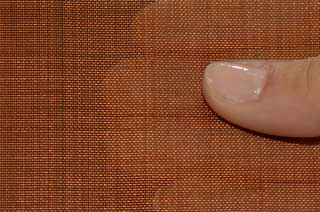Screens let in air & keep bugs out — in general. You may have imagined that screen mesh — the woven stuff stretched into a screen frame — is a rather singular affair, and that you didn’t have many options for what type of mesh you could use. As it turns out, there are lots of options!
FIBERGLASS MESH
Fiberglass mesh is composed of vinyl-coated fibreglass threads, and comes in grey and charcoal colors. This is the most common type of mesh used in window and patio door screens because it’s the cheapest type, it’s easy to work with, and it lays flat and smooth. However, it tends to degrade over time, particularly when exposed to direct sunlight. It’s also easily torn, so birds and pets can wreak havoc on it.
- Fiberglass mesh PROS: inexpensive, easy to work with, smooth
- Fiberglass mesh CONS: easily torn, tends to degrade over time
ALUMINUM MESH
Aluminum wire mesh is fairly common as well, and is used where added durability is desired vs. fibreglass mesh. It’s fairly inexpensive, but can be a bit more difficult to work with, since it shows dents or creases if bent. These dents and creases can also show up in daily use if the screen is pushed or bumped.
- Aluminum mesh PROS: durable, inexpensive
- Aluminum mesh CONS: difficult to work with, shows creases
PET RESISTANT MESH
Sometimes pets can be harsh on screen doors. Fibreglass mesh in particular is fairly easily torn by animal claws, and even aluminum mesh can be torn by a larger dog. For such cases, pet-resistant mesh is available to resist tearing. These are composed of vinyl-coated polyester strands. The strands are much thicker/heavier than the strands in fibreglass and aluminum mesh, and are up to 7 time stronger. Because it’s a heavier mesh, it blocks more light and visibility than standard mesh.
- Pet resistant mesh PROS: very tear resistant, long-lasting
- Pet resistant mesh CONS: can be expensive
SHADE/SOLAR MESH
Sometimes a screen is needed to block light, often to reduce glare or cut down solar heat gain in sunny conditions. There are many different types and grades of shade screen mesh, but all involve a densely-woven mesh that blocks anywhere from 50% to 90% of light. They are similar in feel to fibreglass mesh, and so are fairly easy to work with, but tend to be quite expensive.
- Shade mesh PROS: reduces glare and lights, easy to work with
- Shade mesh CONS: expensive, degrades faster than aluminum mesh
HIGH TRANSPARENCY MESH
Highly-transparent screen mesh is available when more “see-through” screens are needed. These meshes involve much thinner strands in the weave, and tend to be rather fragile, as well as being more expensive than standard meshes.
- High transparency mesh PROS: very transparent
- High transparency mesh CONS: fragile, expensive
STEEL, COPPER, GALVANIZED, ETC…
Other screen meshes are available in brass, bronze, steel, copper, and many other materials. These tend to be used in commercial applications where particular strength and chemical resistance qualities are needed. They are uncommon in residential applications.
MESH DENSITY
Screen mesh is made in a variety of weave densities. The tighter the weave, the more strands there are per inch, and thus the smaller are the holes in the mesh. Most standard insect mesh has around 12-18 strands per inch. This will keep out most typical insects, such as flies and mosquitos. Where smaller insects are a problem, meshes can be used which are up to 200 strands per inch! As you’d expect, these meshes tend to be less transparent, and more costly, than standard meshes.

No comments:
Post a Comment